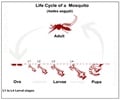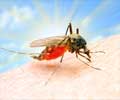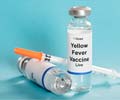
Carmen Perez and co-workers, reporting on dengue vector control in Puerto Rico, found that 83% of the costs ($1.97 per person per year) were funded by the lowest and often the least financed level of government: municipalities.
Examining dengue cases imported into France, Guy LaRuche documented the alarming increase in cases originating from Cote d'Ivoire from only one case in 2006-07 to six cases in 2008.
Using modeling and Monte Carlo simulations, Tiina Murtola and co-authors estimated the "immediate" cost of chikungunya and dengue in India at US$ 1.48 billion (range US$ 0.64 to US$ 3.60 billion).
Tapasvi Puwar and co-workers, reporting on a 2006 household survey in Ahmedabad, found that only 23% of chikungunya cases sought care in public facilities, so that under-reporting must be considerable. Extending the analysis of this chikungunyua outbreak, Dileep Mavalankar and co-authors placed its economic cost at US$ 8.6-17.3 million.
Ami T. Bhavsar and co-authors, studying dengue cases hospitalized at a private hospital in Surat, India, found that the economic cost of a case averaged US$ 585.57 ($439.44 for direct medical costs and US$ 146.13 for indirect costs). Lee Han Lim and coworkers, estimated the "immediate" cost of dengue to Malaysia and Thailand at US$ 133 to $135 million, respectively. Sukhontha Kongsin and co-authors found that on a per capita basis, costs of dengue in Thailand in 2005 averaged US$ 3.55, of which 28% was due to vector control and 72% due to dengue illness.
Advertisement
This special issue (2010) addresses the cost and burden of dengue and chikungunya from the Americas to Asia. The World Health Organization (WHO), sponsor of the Dengue Bulletin, deserves commendation for its decision to publish this special issue (2010) in recognition of the importance and growing burden of dengue and chikungunya.
Advertisement
Nevertheless new preventive strategies are now showing promise[1]. A dengue vaccine is entering Phase 3 clinical testing after successfully completing Phase 2 clinical testing.[2-3] A controlled release to test genetically modified mosquitoes in Asia is expected to begin in 2011.[4]
Each of these control measures, however, requires resources to develop and implement. Quantification of the disease burden in both monetary and human terms is a key tool for health policy-makers. That tool allows them to assess trends over time, to compare dengue and chikungunya against other diseases, and to compare one geographical area with another. It can also allow health practitioners to compare one subgroup of patients with another or select one preventive strategy to guide prevention and treatment most appropriately.
This special issue examines both dengue and chikungunya because the two related viral diseases have similar symptoms of acute fever and joint pain, and are transmitted by the same vectors, the mosquitoes Aedes aegypti and Aedes albopictus (also called the Asian Tiger Mosquito).
The ten original papers in this special issue present a series of approaches and findings to contribute to measuring the cost and burden of dengue and chikungunya from the Americas to Asia.
The papers are arranged geographically from west to east to reflect the longitudinal scope of these mosquito-borne diseases in the tropical regions of the world.
The first paper, Dengue in Brazil: 1999� by Luiz Tadeu Moraes Figueiredo, is based on the paper with the highest western longitude (60o west) in this special issue. Figueiredo's paper focuses on the epidemiology of dengue over an 11-year period. The data show the remarkable year-to-year variation in incidence of the disease. The number of reported cases in the year of highest incidence (718 000 cases) is seven times the number reported for in the lowest year (113 000). In addition to the fluctuation, the author's trend lines confirm disconcerting general upward trends corresponding to an annual rise of 6.2% in dengue cases and 12.0% in dengue deaths in the country.
The second paper, Cost of dengue vector control in Puerto Rico, 2002 through 2007 by Carmen Perez and colleagues, does not examine the disease itself, but the prevention and control activities, primarily through vector control. Perez and co-authors report that surveillance and vector control are implemented and funded through a combination of two levels of local government: the affected municipalities and the state (corresponding to provinces in some other countries). Across the study years, overall annual spending in the island totals US$ 1.97 per capita, of which 83% comes from the 12 municipalities with their own programmes and 17% from the state. Clean-up campaigns had the highest share of average expenditure, followed by fumigation, surveillance and inspection. Puerto Rico's experience highlights the importance of the role of multiple levels of government in dengue prevention.
The third paper, Increase in dengue fever imported from Côte d'Ivoire and West Africa to France, by Guy LaRuche, provides a creative window on a disturbing trend – the increase in dengue in Africa. Reports to WHO document dengue transmission in Africa in recent history since 1948, with recent major outbreaks in Cape Verde (peaking in November 2009) and the Red Sea state of Sudan (peaking in March 2010). Yet the limited dengue diagnostic and surveillance systems provide few statistics. Using surveillance from international travelers for the years immediately preceding these outbreaks, LaRuche confirms a significant increase in dengue in Côte d'Ivoire from only one case in the 18-month study period in 2006-07 to six cases in 2008. This trend and the 148 imported cases to metropolitan France from 2006 to 2008 highlight the value of international cooperation in studying and controlling the disease.
The fourth paper, A preliminary estimate of the immediate cost of chikungunya and dengue to Gujarat, India, by Tiina Murtola and co-authors, is one of two papers in this special issue to use Monte Carlo simulations with existing data to extrapolate the annual burden of dengue or chikungunya to a state or national level. To address the fact that existing surveillance systems capture only a fraction of the actual cases, this paper develops the "RUHA" matrix by estimating shares of reported (R) and unreported (U) hospitalized (H) and ambulatory (A) dengue cases. The paper calculates that the immediate cost to households of chikungunya and dengue in the state of Gujarat was estimated to be 3.8 (range 1.6-9.1) billion Indian rupees (INR) per annum.
The fifth paper, Prevalence of chikungunya in the city of Ahmedabad, India, during the 2006 outbreak: A community-based study, by Tapasvi Puwar and co-authors, describes an extensive household survey of 1301 households across 43 clusters. It ascertained the magnitude and characteristics of the disease in the city of 3.5 million persons. The authors found that 32.9% of the persons surveyed experienced the disease, of which the major symptoms were fever, chills, headache, joint swelling and itching. The prevalence was higher in slum neighbourhoods (where more than 40% of the population lived) than in ones with bungalows and apartments. The municipal authority officially reported 60 777 cases within the city limits. However, the survey found that only 23% of cases sought treatment within public facilities compared with 68% from private facilities and 9% that sought no treatment. Thus, they conclude that the official reports may substantially understate the total burden of illness.
The sixth paper, Prevalence of various symptoms and cost of treatment during chikungunya epidemic in Ahmedabad, Gujarat, India, by Dileep Mavalankar and co-authors, estimates the economic cost of the 2006 outbreak of the viral disease with further analyses of the survey data provided in the previous paper of Puwar et al. The sixth paper notes that the disease affected primarily working-age adults, with the highest number of cases occurring in the age decade of 30. For this neglected disease in this one city, the authors estimated that the immediate cost of the outbreak due to lost wages and treatment costs was approximately US$ 1.7 million based only on officially reported cases. Assuming that the actual number of cases may be 5 to 10 times the reported number, the actual economic cost of the chikungunya outbreak in Ahmedabad may have been US$ 8.6 to US$ 17.3 million, respectively.
India is also the setting of the seventh paper, A private hospital-based study assessing knowledge, attitude, practice and cost associated with dengue illness in Surat, India, by Ami T. Bhavsar and colleagues. As many private facilities and their patients are often reluctant to share their data with researchers, most studies of disease cost and burden are set in public facilities. This paper, set in a medium-sized private hospital in the city of Surat in Gujarat, India, is a welcome exception. The study found that for an average inpatient dengue episode in this facility, direct medical costs averaged US$ 439.44. Indirect costs added US$ 146.13, bringing the total cost per case to US$ 585.57. The study's survey found considerable scope for enhanced prevention. Only 25% of respondents correctly answered that the dengue vector breeds in clean, stagnant water. Fully 93% of households stored water for daily use, a practice that facilitates mosquito breeding. Finally, the study demonstrates dramatically that dengue affects all economic strata. Ninety per cent of hospital patients came from the higher socioeconomic strata compared with only 39% of the population in urban Gujarat.
The second paper modelling the economic impact of data from multiple sources is the eighth paper in this special issue, Immediate cost of dengue to Malaysia and Thailand: An estimate, by Lee Han Lim and co-workers. The study is notable for deriving comprehensive estimates of dengue cost in both countries and exploring the uncertainties in existing data. The authors found the "immediate" annual cost of dengue to be in the range of US$ 88 to US$ 215 million (mean of US$ 133 million) for Malaysia and US$ 56 to US$ 264 million (mean of US$ 135 million) for Thailand. In Malaysia, the most important parameters creating uncertainty in the immediate cost are the reporting rate, the hospitalization rate, and cost per ambulatory case. In Thailand, the corresponding parameters are cost per ambulatory case, cost per hospitalized case, and reporting rate. To improve estimates of dengue costs, future studies should also refine the estimates of the hospitalization rate in Malaysia and the cost per hospitalized case in Thailand.
Similar to the study from Surat, the ninth study, Cost of dengue in Thailand by Sukhontha Kongsin and co-authors, is primarily based on a facility-level observational study of dengue patients. The authors found that the economic cost per non-fatal case in Khon Kaen Provincial Hospital in 2005 averaged US$ 573. Some previous economic studies have examined only household out-of-pocket payments for treatment. This study measured total resource use from all sources, including government, households and employers. On average, inpatient care cost US$ 418 per case, almost all is paid for by the government. Ambulatory care and direct non-medical care (mostly transportation) averaged US$ 49 and US$ 60 per case, respectively. Further, indirect costs (the value of time lost) averaged US$ 45 per case, mostly incurred by households. Thus, all payers incur substantial costs for a dengue case.
Finally, the paper also estimated the cost of vector control, an important dimension that is empirically derived in very few studies. Overall, per capita costs of dengue in Thailand in 2005 were US$ 3.55, of which 28% was due to vector control and 72% due to dengue illness.
The tenth study, Clinical characterization, diagnosis and socioeconomic impact of hospitalized dengue in Cambodia, by Jose A. Suaya and co-authors, uses the same data collection instruments and methods as the ninth paper (from Thailand). When measured in US dollars, the resource cost of a hospitalized dengue case in Cambodia (US$ 116) was substantially less than that in Thailand. Yet the economic hardship associated with a dengue hospitalization in Cambodia was extraordinarily high, with the majority (88%) of households having these cases reporting a substantial adverse economic impact. For example, to pay for treatment, 39% of the households needed to borrow money beyond family or friends, and 53% needed to sell household property. These adverse effects are the combined results of considerably lower per capita income and the requirement in Cambodia that patients pay out-of-pocket for the majority of hospital costs, even in a government hospital. Thus, hospitalized dengue has major clinical and socioeconomic consequences in Cambodia.
Overall, these ten studies document the substantial and growing burden of dengue in the Americas, Africa and Asia. Effective methods to prevent the disease would, therefore, result in important economic benefits in many tropical countries.
Source-Eurekalert











